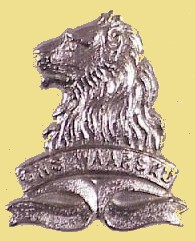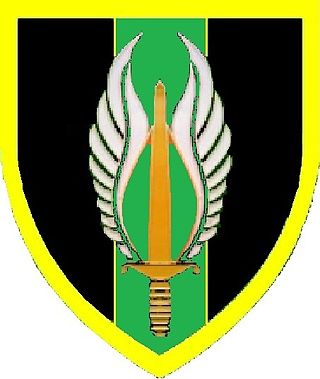
The South African Army is the principal land warfare force of South Africa, a part of the South African National Defence Force (SANDF), along with the South African Air Force, South African Navy and South African Military Health Service. The Army is commanded by the Chief of the Army, who is subordinate to the Chief of the SANDF.

The South African 3rd Infantry Division was an infantry division of the South African Army during World War II.

The South African Army Infantry Formation supervises all infantry within the South African Army.

The Andrew Mlangeni Regiment is a reserve infantry regiment of the South African Army.

The General de la Rey Regiment is an reserve infantry regiment of the South African Army.

The Ground Forces Command at Victory Base Complex near Baghdad Airport was the most important fighting formation in the Iraqi Army. The headquarters of the Iraqi Ground Forces Command and the Iraqi Joint Forces Command are the same entity.

44 Parachute Brigade was a parachute infantry brigade of the South African Army. It was founded on 20 April 1978, by Colonel Jan Breytenbach, following the disbandment of 1 SA Corps and the battle of Cassinga. Upon formation, the brigade was commanded by Brigadier M. J. du Plessis, who was assigned the task of establishing by working with the Parachute Staff Officer, Colonel Jan Breytenbach. At the time du Plessis was the commanding officer of the Orange Free State Command and had previous experience serving in 1 Parachute Battalion. Breytenbach had also been a member of 1 Parachute Battalion and had also founded the South African Special Forces Brigade and 32 Battalion. The location that was chosen for the brigade's headquarters was in the lines of the OFS Cmd Headquarters, next to the old Tempe Airfield in Bloemfontein.

The Steve Biko Artillery Regiment is a airborne artillery regiment of the South African Artillery.

The Job Masego Regiment is a reserve mechanised infantry regiment of the South African Army.

Orange Free State Command was a command of the South African Army, active from c. 1933 to c. 1999. Its headquarters was at Bloemfontein, seemingly for a period at the Tempe airfield, later to become the Tempe Military Base.

Western Province Command was a command of the South African Army.

7 South African Infantry Division was a formation of the South African Army, active from the 1960s to 1999.
This page details the South African Army order of battle in 1940, before and after the formation of expeditionary forces.

The OR Tambo Regiment is a reserve infantry regiment of the South African Army.

8 South African Armoured Division was a formation of the South African Army, active from the 1970s to 1999.

71 Motorised Brigade was a formation of 7th South African Infantry Division, a combined arms force consisting of infantry, armour and artillery.

81 Armoured Brigade was a Formation of 8th Armoured Division, a combined arms force consisting of armour, mechanised infantry, and mechanised artillery.

84 Motorised Brigade was a formation of 8 South African Armoured Division, a combined arms force consisting of infantry, armour and artillery.

72 Motorised Brigade was a Formation of 7th Infantry Division, a combined arms force consisting of infantry, armour and artillery.





















